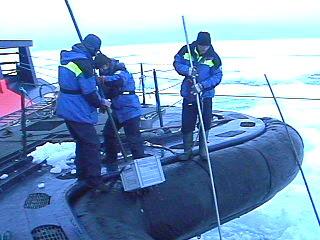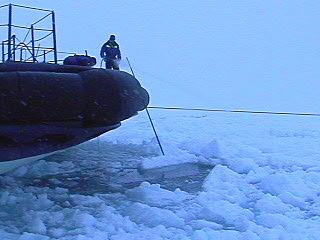
|
|
2 August, 2001
Let it Snow, Let it Snow, Let it Snow
Thursday, 2 August 2001
Hej!
Life on Board
This morning, my roommate looked out the window and said that with the snow
coming down so hard, it looked like a January day in Stockholm except that
it was too light. I never thought I would say this, but I can't WAIT to
see the sun go down and have a nighttime that is dark. Think about it.
Every minute of every day the light appears exactly the same to the eye. I
guess there is some slight variation, but it is pretty much undetectable
without instruments. Think about what this would do to your daily body
clock. I wonder what strange chemistry is going on in there. It will be
an interesting and wonderful adjustment to see a dark sky again with stars
and a moon.
Where Are We Now?
We didn't end up with gale force winds, but they got up to 15 meters per
second, which is pretty strong (I don't feel like doing the work to get it
into mph without a calculator, but that is more wind than you want to be
out working in, especially with heavy, horizontal snowfall). I know that
the kite flying team won't put up a kite at more than 8 m/s. I felt sorry
for the people working out at the main mast construction site because I
heard that the winds increased vertically. This morning, our coordinates
were 88o57'N by 1o21'W. By 7 pm they were 88o53'N by 2o28' W, so everybody
is happy because we are drifting westward, which is what we want.
Scientists at Work
When they docked the ship at our ice floe, they backed into a little harbor
they had created so that the back and sides of the ship were right against
the ice for stability. This created a problem for us this morning because
we needed to do a CTD cast to get water samples, and the winch for the CTD
rosette is on the aft (back) deck. They couldn't pull the ship forward
because they had already put the ice anchors in and also, they don't want
to turn on the engines again because it would pollute the area. So they
decided to attempt to break through the pack ice by hand. First, they
tried just bashing through the ice by dropping the large metal transport
basket from the crane onto the ice pack. This resulted in a broken
transport basket, and some broken ice. Then, they tied a large grate onto
the crane line in a horizontal position and they manually lifted and
scooped blocks of ice onto it then dumped them along the sides of the ship.
After the big blocks were moved, there was still a thick layer of smaller
blocks and slush, so they tied milk crates onto long boat hooks and dipped
them into the slush. As they brought them up to the deck, the seawater
drained out the bottom and they would dump the slush onto the deck behind
them. My lab partner, Brian Thompson, would sweep the slush away from the
edge and into a pile and then my job was to shovel this slush off the side
of the ship. Lastly, they used a hose with warmer (15 oC) water from the
engine room to push the ice back but the scientists didn't really want this
polluted and warm water mixed into the seawater (-1 oC) in their sampling
site so that was stopped. So six hours later, with a great amount of help
from the crew, we succeeded in making a little "pond" of open water behind
the ship. OK, now we have to get to work!
We took samples from seven depths, down to 200 meters, then had to process
them in the lab. I did my normal filtering and preparation routine, which
takes about two hours for that many samples. Paty Matrai, my Principal
Investigator (my boss on this trip), used the Gas Chromatograph instrument
to search for the illusive compound dimethyl sulfide in the samples, which
gives her an idea as to how much bacteria and other organisms are living
and reproducing in the seawater here. We also added other chemicals to
some of the sample bottles to see how the bacteria in the water would react
and set them outside in a container of cold seawater to "incubate" for 24
hours (they call it incubate although I always think of warmth and baby
chickens when someone mentions "incubate").
Later that night, the Oceanography group wanted to do a deep CTD cast to
collect information on salinity, temperature, and seawater density at great
depth. They went down to 4414 meters. To give you an idea of how deep
that is, Peter Winsor, one of the CTD team members from Gothenberg
University in Sweden, told me he was disappointed that they didn't go 20
meters deeper. When I asked him why, he replied that with 20 meters more,
the total of depth down plus depth up would be equal to the height of Mt.
Everest!
EMAIL Even though I can send email out, I haven't been able to read my
email at all for several days so I'll just say hello to everyone!
Vi ses! (See you later!)
From Deck 4 on the Icebreaker Oden, drifting west, 88 North
Dena Rosenberger



At last, a little pond!
Contact the TEA in the field at
.
If you cannot connect through your browser, copy the
TEA's e-mail address in the "To:" line of
your favorite e-mail package.
|
